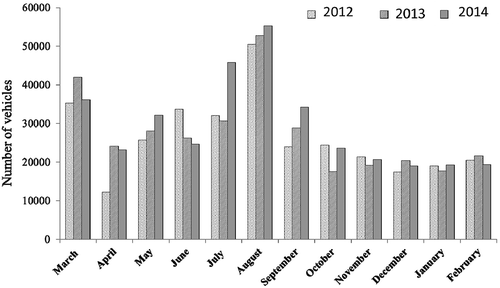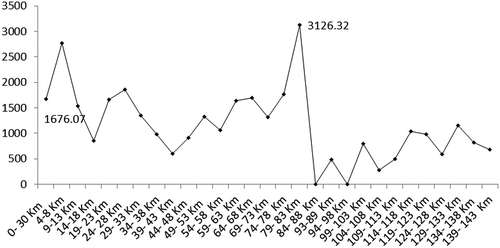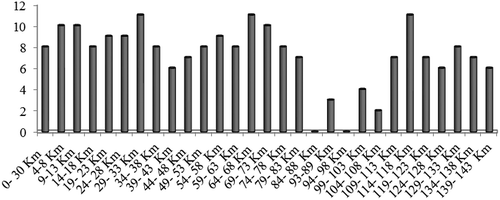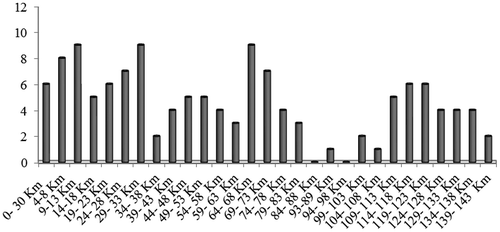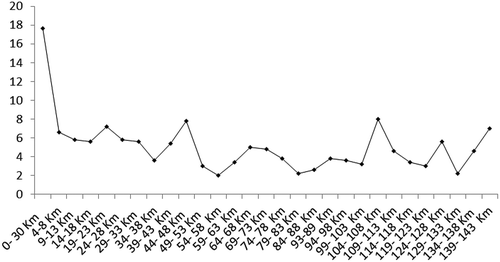 ?Mathematical formulae have been encoded as MathML and are displayed in this HTML version using MathJax in order to improve their display. Uncheck the box to turn MathJax off. This feature requires Javascript. Click on a formula to zoom.
?Mathematical formulae have been encoded as MathML and are displayed in this HTML version using MathJax in order to improve their display. Uncheck the box to turn MathJax off. This feature requires Javascript. Click on a formula to zoom.Abstract
Transport and communication are the major sectors of economy in any country, and this phenomenon is known as one of development indices of countries. Therefore, safety management and road accident reduction are taken into account as key issues. The first step for controlling road accidents is to identify the accident process and factors influencing it. In recent years, considerable researches have been conducted to perceive the relationship among number of accidents, traffic volume, road geometric parameters and environmental factors in the form of accident prediction models. These models are strong tools in analyzing accident and employed for identification and analyses of accident black spots in suburban roads. The use of prediction models obtained from the accurate statistical methods and information of roads and accidents not only are effective in evaluating the managerial and geometric corrections of roads but also make the identification of accident black spots easier and accessible. Present research tried to offer a model for investigating the effect of geometric parameters influencing safety promotion and accident reduction of suburban roads by the use of collected databases. Finally, effective variables have been used for modeling. Then, using statistical data and field work in the studied road, accident analysis models have been performed on them and effective variables have been identified. Also, measures have been conducted for solving problem and safety promotion of roads.
PUBLIC INTEREST STATEMENT
Road safety is one of the most important problems of developing countries. Many people in last decade are died because of road accident. This study explores Iranian Road safety. Safety measures were provided, and they were asked to rate their effectiveness such as geometric characteristics of road curves, curve radius, wave length, central. However, due to the geographical conditions in this road, parameters horizontal and vertical curves properties were investigated. The share of geometric parameters in accidents was not the same in different groups of classification of this path due to the specific geographical conditions.
The study showed that the first 45 km of the path is located in mountain and Sub-Mountain areas investigating the accidents in black spots of this road section; this fact is evident that most of road accidents have been occurred in steep slopes, non-standard curves and intersections.
1. Introduction
Nowadays, increasing road safety has become one of the most important problems of developing countries in the transportation and economic sectors. In recent years, noticeable studies have been conducted in all over the world to perceive the relationship among number of accidents, traffic volume, road geometric characteristics and environmental factors in the form of accident prediction models (Tabatabaei, Hosseinian, & Gharanjiki, Citation2011). In the last few decades, road safety modeling has allocated the considerable share of researches to itself due to the widespread weakness of practical programs to promote safety in types of transportation methods. In these years, engineers and planners of traffic and transport have identified factors such as traffic, geometric design that has more effect on the frequency and severity of accidents. They have conducted numerous measures to improve road designs and driving in a safer environment and identified the accident black spots of roads (Rahim & Heydarzadeh, Citation2014). Road accidents have heavier damages than urban ones and often lead to the heavier human and financial damages due to high speed of vehicles. In addition, road accidents are the most important factor of injuries and include 25% of fatalities caused by it (Ahadi & And Etemadzadeh, Citation2013).
Figure 7. The bar graph for the identification of accident black spots through accident frequency method.
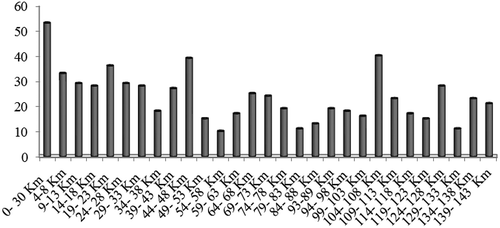
Accident black spots that are determined based on the accident statistics are identifying and investigating by related organization in Iran for several years. Based on the experience of other countries, elimination of hazard in these areas that are sometimes lead to the heavy financial costs can save the lives of many of our countrymen (Gohar Pour & Ramezani Fard, Citation2005). Investigation and study of accident black spots in Iran are in the low level due to the lack of systematic planning and prioritization of these areas as well as lack of significant databases in which information of accident black spots of the country would be registered and after supplying validity and implementing corrective actions of its data would be updated. While valid scientific methods are not employed for their identification and prioritization and after spending costs and making them safe, efficacy and accident reduction in these areas will not be assessed (Pak Gohar, Saffarzadeh, & Khalili, Citation2009). Today, various researches have been conducted on accidents but what is available is more the statistics of accidents. Number of deaths, number of injured people, crashed vehicles and age of injured people are not recorded in accidents. At the 11th International Conference on Traffic and Transportation Engineering in Iran, Dirin, Mansourkhaki, and Bagheri (Citation2012) stated that (for two-lane two-way roads) if the average annual daily traffic volumeis greater than 2000, the probability of crashes for a narrow width road or no shoulder increases drastically and if no shoulder is present, the chance of a crash increases by 50%. The shoulder type governs the crash frequency. A paved shoulder is the best type of shoulder in terms of road safety and better than gravel shoulders. A gravel shoulder is better than a composite shoulder (combination of different types). However, a turf shoulder is considered to be the worst in terms of road safety and can lead to 10% more crashes. Saffarzadeh, Shabani, and Azarmi (Citation2007) studied the accident prediction model in curves located in two-lane suburban roads. The results showed that 50 to 60% of accidents have occurred on two-lane suburban roads that half of the accidents have taken place on road curves, and 70 % of accidents on road curves have occurred on horizontal ones. Moreover, the results indicated that in two-lane suburban roads, road geometric design variables such as curve radius, superelevation, curve length, curve degree, the width of road at the curve spot and daily traffic volumeare of contributing factor in the occurrence of traffic accidents. Perkins and Harols (Citation1983) in his study divided the effective factors on accidents into two general parts of functional and non-functional. His results showed that road width has a key role in accidents but shoulder width has little effect in accidents on curves. Deacon, Zegeer, and Dean (Citation1975) conducted a research to evaluate severity of accidents and their modeling. They offered the numerical weight of 9.5 to convert types of accident severity to damage only property accidents, the numerical weight of 1.8 for minor and moderate injuries. In the USA, in 1977, in a research work, they obtained costs of accidents in terms of the severity of accidents and offered numerical weight of 19 for fatal accidents and severe injuries. (Proposal) Neuman, Glenon, and Sagg (Citation1991) in the state of Washington with a choice of 334 curves from two-lane roads located in four states of USA and studying the effect of five variables: average daily traffic, arc, arc degree, arc length, arch width, roadway width and shoulder width on road accidents using covariance analysis concluded that except average daily traffic, other variables have a major role in accidents on curves. (Proposal) Hauer (Citation2000) studied the drivers in Canada and their results showed that most of accidents have occurred in slop parts of road relative to the direct surfaces. Also, the results demonstrated that increasing the percentage of slop lead to increase the number of accidents so that by increasing one unit to slop percentage, the number of accidents increases 1.6 %.
The improvement of road safety has become the main priority of transportation aims due to very high costs of accidents in highways, freeways, main, subsidiary and rural roads. Authorities of safety affairs and transportation are trying to reduce accidents by increasing traffic safety through the enforcement of road traffic laws, monitoring law enforcement, education, culture, using regional and local traffic control and improving the road geometry. The researches show that reduction of accident rates is due to design improvement and road safety increase (Rahim & Heydarzadeh, Citation2014). Geometric design is affected by the importance of road and importance of grids that the road is portion of it. One of the aims of geometric design is achieving safe transportation. To achieve safety, there are different goals such as reduction of fatal accidents, tangible reduction of injury accidents, reduction of financial damages, promotion of road safety through correction of hazardous spots (black spots) and presenting the optimum models to predict road accidents. Generally, a good design cause a comfort and stable environment for drivers. By using the mentioned principals, drivers can move suitable and safe on road or on an interference situation (such as intersections). Even if the driver is wrong, the road design should be such that the driver without accident is able to correct his mistakes or to minimize its severity in case of accident (Asadollahi, Citation2010). As we know, different paths have different models. Therefore, the aim of this research is to offer a model for predicting accidents on Bojnurd-Golestan National Park road. Hence, the geometric parameters most involved in accidents were investigated. Among them, the best option that had priority in terms of safety cost was selected.
2. Material and methods
2.1. Research scope
Bojnurd-Golestan National Park road is part of the international Bojnurd-Gorgan road that has been constructed to connect and transit goods of eastern and northeastern regions to north, center regions of Iran and Caspian Sea margins since many years ago. The total length of this road, which is situated in North Khorasan province and is our research area, is 141 km (Golestan jungle tunnel) that is shown in Figure .
2.2. Accident black spot identification methods
Nowadays, accident prediction models are strong tools in the analysis of accidents. They are used to identify and analyze black spots of roads and identify the effective factors on safety. Generally, the mentioned models identify and analyze the studied sections through applying traffic information, statistics, geometric characteristics and other related and effective parameters. According to the results obtained from models, road safety conditions can be evaluated before accident occurrence and appropriate preventive strategies can be applied in managerial stages and decision-making. Selection and optimum identification of effective variables in the model is a very sensitive and crucial issue and is known as main bases of a model. Thus, the appropriate identification of these variables to offer a model provides a great help for the process and next stages in modeling and more validity and effectiveness for the model result. It is evident that the use of ineffective and unrelated variables will lead to the inefficiency of the model.
2.2.1. Accident number method
This method is one of the most simple, explicit and easiest methods for identification of accident black spots. In this method, spots and sections that have the highest number of accidents are known as black spots. The location and time of all accidents should be recorded. The use of spots of map is the best way to maintain the information and PIARC manual (PIARC, Citation2003; and Anonymous, Citation2007).
Frp: Frequency mean of accidents
Fj: Accident frequency of j place in statistical society
N: Number of places
2.2.2. Accident rate method
The accident rate is defined as the ratio between number of accidents and number of available vehicles. This method uses the accident rate that is calculated through traffic and accident parameters by considering traffic volumeinstead of number of accident (Anonymous, Citation2007).
Rj: Accident rate in j place (accident per million vehicle-kilometers)
Fj: Accident frequency of j place
Lj: The section length of j place
Qw: Annual Average Daily Traffic (AADT)
: Accident rate average (accident per million vehicle-kilometers)
: Average annual daily traffic (AADT)
2.2.3. The equivalent property damage only method (EPDO)
The equivalent property damage only by assigning one weight to each accident, which is a function of the worst level of injuries in accidents, gives greater value to the more serious injuries. For this purpose, different coefficients have been suggested. Saffarzade, Pirdavani, & Abdi, Citation2008 has proposed the following coefficients: property damage-only accident is equal to 1, injury accident (moderate or minor injury) is 3.5 and fatal and injury accident (severe or serious injury) is 9.5. Weighting coefficients that are assigned to each group of accidents usually express their real costs.
EPDOj: EPDO of j place
Wi: weighting coefficient of accident type i
Fij: accident frequency of j place
N j: number of accidents occurred in spot or section j
n: total number of section located in j path or total number of spots in j path
2.3. Research methodology
In this research, accident models in Bojnurd-Golestan National Park road were investigated. The required parameters for the model were derived from the map. From a statistical point of view, information availability of a large number of accidents is good. It is often assumed that 3 years could be a reasonable period for the analysis. A 3-year period creates an appropriate balance between adequate time to have a lot of accident information and short time for lack of noticeable changes of black spots. In this research, the geometric parameters of black spots were investigated and it was revealed that to what extent the defects of geometric parameters will be effective in increasing safety (16). These parameters include mean radius of path, curve length of path, number of curves in the path, number of horizontal curves that are very close to each other, accesses and interference of horizontal and vertical curves. Then, parameters of the model were investigated and correlation tests were conducted on them. The correlation of model parameters and its model were determined. In addition, the required graphs were drawn. To offer proper solutions for reducing accidents, investigation of accident statistics and evaluation of effective factors is of crucial importance. The daily traffic statistics of Bojnurd-Golestan National Park road were investigated to study the path characteristics. These statistics have been extracted based on 2012 to 2014.
2.4. Statistical models
To investigate the influence of each of effective parameters on number of accidents or accident rates, sensitivity analysis is performed on the models to determine the share of each of the effective parameters on dependent parameters. To develop a better relationship between them, it is better to use the regression method to determine better relationship among variables. Regression models display the best relationship between dependent and independent variables using statistical and mathematic methods, so that dependent variables have the most correlation with independent variables and can describe it best.
At first, to investigate the location of the studied path, independent variables in this path were identified using Google Earth software and field survey, and the geometric characteristics of the path were examined and measured (Figure –). Then, the path was drawn by the use of collected data in AutoCAD. Geometric characteristics of curves such as curve radius, wave length, central angle and curvature coefficient were extracted. Central angle was used as a criterion for classification and identification of the amount of path curving development. Wave length and road length are two main parameters in determining curvature coefficient. Curvature coefficient for each curve can be calculated through the following formula:
S: curvature coefficient
L: length of curve
ʎ/2: half of wave length
Also, the central angel of curves is obtained through the following formula:
A: central angel
R: radius of fitted circle
According to the definition, the curvature coefficient larger than 1.4 to 1.5 shows that the path is curving and the curvature coefficient less than it shows the path is straight.
As shown in Figure , the amount of daily traffic of vehicles has increased each year compared with the last year.
3. Results
In the section of descriptive statistics, the data analysis has been conducted using measures of central tendency such as mean, median, measures of variability of standard deviation and skewness. Summary of descriptive statistics related to the model variables is presented in Table – after screening and deleting outliers using SPSS.
The above table shows that the studied path is divided into 29 sections. In the following, for better description, each variable was reviewed based on the studied path length separately. Some variables are shown as an example.
In addition to independent variables, four variables including number-rate, EPDO, accident frequency and accident rate were investigated as dependent variables each of which was analyzed descriptively before performing the regression model.
Table 1. Classification of path based on the curvature coefficient
Table 2. Descriptive statistics corresponding to observations
After the descriptive investigation of variables, the distribution of dependent variables should be investigated. In this research, the method of least squares was used to estimate the parameters of regression model. This method is based on the assumption that the residuals of regression model are normal and this will be occurred when the dependent variable have normal distribution so that the non-normal distribution of dependent variable leads to the violation of assumptions for estimating parameters and do not offer correct results. Hence, normality of data was studied through Kolmogorov–Smirnov test. The summary of Kolmogorov–Smirnov test results is presented in Table . The following table displays that the significance level of above test is greater than 0.05 for all four variables in identification of accident black spots. Therefore, normality hypothesis of observations is accepted for all variables (p > 0.05). The p-value, or calculated probability, is the probability of finding the observed, or more extreme, results when the null hypothesis (H 0) of a study question is true—the definition of “extreme” depends on how the hypothesis is being tested. In the majority of analyses, an alpha of 0.05 is used as the cutoff for significance. If the p-value is less than 0.05, we reject the null hypothesis that there is no difference between the means and conclude that a significant difference does exist.
The aim of this research was to identify the geometric parameters influencing accident black spots. Thus, on the basis of the expressed theoretical issues, the following regression model was used to investigate and analyze the geometric parameters influencing in safety promotion and accident reduction.
The results of the regression model 2 are presented below considering the dependent variables:
Number-Rate (dependent variable)
The results in Table demonstrates that Fisher’s statistic () is greater than the corresponding statistic in Fisher’s table. Thus, the fitted model is significant and have acceptable performance (p = 0.027 < 0.05). The coefficient of determination in the mentioned model shows that 21.9% of variations of number-rate index are due to variations of independent variables such as proximity of two curves, accesses and the average of central angle. The significance level of regression coefficients in the mentioned variables are less than 0.05 (p = 0.000 > 0.05(; therefore, the effect of all variables on number-rate index is significant. Also, the amount of tolerance statistic is more than 0.5 and validity of the model is approved. With regard to the standardized regression coefficients, it can be concluded that variables of the average of central angle, accesses and proximity of two curves are the most important factors influencing the number-rate index, respectively.
Table 3. Summary of Kolmogorov–Smirnov test results
Table 4. Regression coefficients for regression pattern of number-rate index
Table 5. Regression coefficients for regression pattern of EPDO
Table 6. Regression coefficients for regression pattern in accident frequency index
EPDO (dependent variable)
The coefficient of determination in the mentioned model shows that 33.4% variations of EPDO are due to variations of independent variables such as accesses and average of central angle. The significance level of regression coefficients in the mentioned variables are less than 0.05 (p < 0.05); therefore, the effect of all variables on number-rate index is significant. Also, the amount of tolerance statistic is more than 0.5 and validity of the model is approved. With regard to the standardized regression coefficients, it can be concluded that variables of accesses and average of central angle are the most important factors influencing EPDO, respectively.
Accident Frequency (dependent variable)
The coefficient of determination in the mentioned model indicates that the 34.1% variations of accident frequency is due to the variations of independent variables such as sum of curve length, number of curves, accesses and average of central angle. The significance level of regression coefficients in the mentioned variables of sum of curve length, number of curves, accesses are less than 0.05 (p < 0.05); therefore, the effect of the above variables on accident frequency index is significant. Also, the amount of tolerance statistic is more than 0.5 and validity of the model is confirmed. With regard to the standardized regression coefficients, it can be concluded that sum of curve length, number of curves, accesses and average of central angel are the most important factors influencing accident frequency index, respectively.
4. Conclusion
According to the data analysis, statistical inferences and information derived from the results, it was concluded that:
Investigating the dependent variables including accident number, accident rate, EPDO and number-rate indicated that the results obtained from dependent variable of accident frequency are very reasonable and close to the reality. Since the traffic volumeof this road is variable in different years but black spots are constant. Thus, it is necessary to investigate the spots that have capacity to be converted to black spots because they can be converted to black spots in the futures.
Many geometric parameters are involved in accidents in a path; however, due to the geographical conditions in this path, parameters of sum of curve length, number of length, curve interference, proximity of two curves, accesses, radius mean in curve, average of curve length and average of central angle were investigated. The share of geometric parameters in accidents was not the same in different groups of classification of this path due to the specific geographical conditions.
According to the statistical results obtained from dependent variables, there is a significant relationship between number of accidents and accesses. In the field study, it has been observed that the role of accesses is highlighted in the first 85 km of the path due to the existence of numerous villages in the path that are joined with an entrance to the main road. However, in this path, due to fertile agricultural grounds, the possibility of traffic of trucks and agricultural implements can play an important role in occurrence of accidents as well.
Given that the parameters of curvature coefficient and wave length are used as an independent variables to calculate the central angle, but many factors such as curve radius, curve length, proximity of two curves and even curve interference are affected by central angle variation and can be effective in accident effectiveness as dependent variable. Therefore, it can be concluded that all above-mentioned factors have a significant role in the occurrence of accidents.
Considering that the first 45 km of the path is located in mountain and sub-mountain areas and has multiple curves, in investigating the accidents in black spots of this road section, this fact is evident that most of road accidents have been occurred in steep slopes, non-standard curves and intersections. Road bends are the potential road accident black spots because of misleading transfer of curvature in the road design, lack of sufficient field of view, out of control and sliding of vehicles especially in slippery roads. Therefore, the technical principals and standards should be considered in designing different curves, but they have not been applied in this path yet.
Additional information
Funding
Notes on contributors
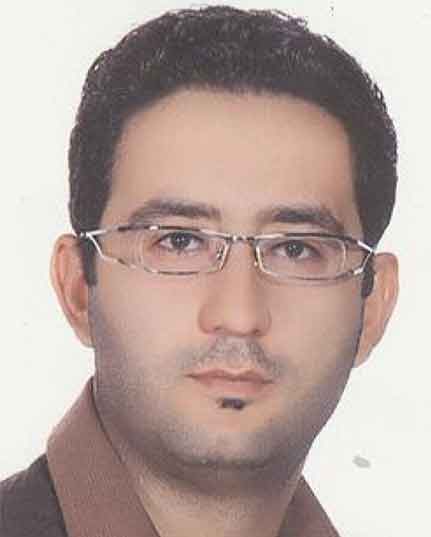
Abbas Karimi
Abbas Karimi is a Graduated M.Sc, Department of Civil Engineering, Shahrood Branch, Islamic Azad University, Shahrood, Iran since 2017.
Ehsan Kashi
Ehsan Kashi is an assistant professor/Department of Civil Engineering, Shahrood Branch, Islamic Azad University, Shahrood, Iran since 2015. He has completed his PhD in Highway and Transportation engineering from Semann University in Iran (2016). He worked in some University as master thesis advisor and supervisor (2015/2018). He is Managing Editor in journal of Transportation Infrastructure Engineering since 2012. http://jtie.journals.semnan.ac.ir/?lang=en
References
- Ahadi, M. R. , & And Etemadzadeh, S. R. (2013). The effect of geometric design parameters on safety promotion and road accident reduction (Case study: Sari-Kiasar road). Journal of Safety Promotion and Injury Prevention , 1(3), 102–115.
- Anonymous, A. (2007). Analysis of accidents, identification and correction of accident blackspots (pp. 180). Publication of Ministry of Roads and Transportation, Deputy for Education, Research & Technology, publishing researches and information unit.
- Asadollahi, R. (2010). Examination of driver’s safety and view conditions at combination place of horizontal and vertical curves in road geometric design. ISC Journal of Rahvar , Seventh Year, 12, 32–47.
- Deacon, J. A. , Zegeer, C. V. , & Dean, R. C. (1975). Identification of hazardous rural highway location. Transportation Research Record , 543, 16–33.
- Dirin, M. , Mansourkhaki, A. , & Bagheri, G. H. , (2012). The mathematical model of road geometric parameter role in safety of two-lane suburban roads, 11th conference of transport and traffic engineering of Iran, Tehran, transport and traffic organization of Tehran, Transportation and Traffic Deputy of Tehran Municipality.
- Gohar Pour, A. A. , & Ramezani Fard, A. R. (2005). The effect of accesses on road accidents (case study: Hamedan province). ISC Bimonthly Bana , (26), 65–73.
- Hauer, E. (2000, September 1998). Safety of horizontal curves, HSIS-HSDM, March 24, Canadian research test driver response to horizontal curve (1998). Road Management and Engineering Journal .
- Neuman, T. R. , Glenon, J. , & Sagg, J. (1991). Accident analysis for high-way curves . Washington, DC: TRB 923.
- Pak Gohar, A. R. , Saffarzadeh, M. , & Khalili, M. (2009). Probabilistic model of three factors affecting road accidents in Iran. Journal of Rahvar , 7, 73–86.
- Perkins, D. D. , & Harols, T. T. (1983). Candidate accident surrogate for high safety analysis . Transportation Research Record.
- Praticò, F. G. , & Giunta, M. 2012. Quantifying the effect of present, past and oncoming alignment on the operating speeds of a two-lane rural road. The Baltic Journal of Road and Bridge Engineering , VII(3), 181–190. Vilnius: Technika. doi:10.3846/bjrbe.2012.25.
- Praticò, F. G. , & Giunta, M. (2014). Safety evaluation: A new operating speed model for two-lane, undivided rural roads, advances in transportation studies. An International Journal, Section B , 34, 67–80.
- Rahim, F. K. , & Heydarzadeh, J. (2014).Examining the effect of road geometric design parameters on the rate of road accidents’, third national conference on road, rail and air accidents, p 1–9
- Road Safety Manual (PIARC, 2003) . (2003). Permanent International Association of Road Congresses.; PIARC technical committee on road safety . Switzerland R[o]ute 2 Market.
- Saffarzadeh, M. , Pirdavani, A. , & Abdi, A. (2008). Identifying the effective criteria for prioritizing accident black-spots and their measure of importance. Transportation Research (Journal of Transportation) , 5(2), 145–156.
- Saffarzadeh, M. , Shabani, S. , & Azarmi, A. (2007). accident prediction model located in two-lane suburban roads. Journal of Transportion , fourth year, (3).
- Tabatabaei, S. , Hosseinian, S. , & Gharanjiki, B. (2011). General health, stress associated to the work and job satisfaction of hormozgan cement factory employees in Iran. Procedia - Social and Behavioral Sciences , 30, 1897-1901.


